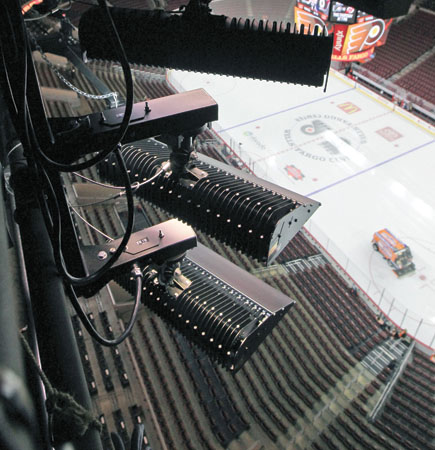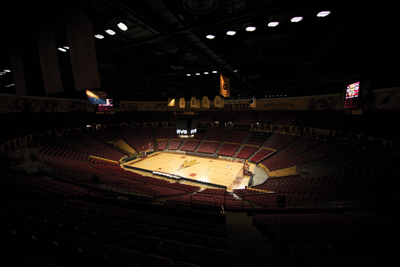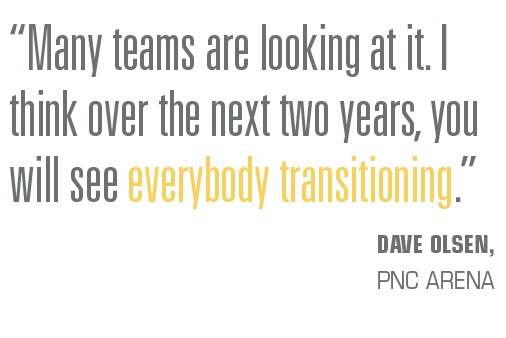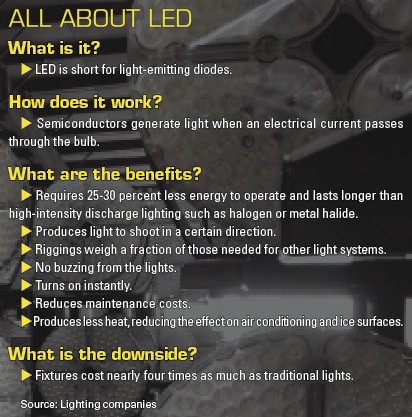The evolution of LED technology is pointing the spotlight on sports facilities looking to cut energy costs.
Light-emitting diodes, the same technology behind video boards at arenas and stadiums, has expanded to include sports lighting over the past two years, beaming its way down to the field of play at big league, college and minor league facilities.
In the big leagues alone, multiple venues are replacing their old metal-halide lighting systems with LED sports lights, which vendors tout as brighter, longer lasting and cost efficient.
 |
Newly installed LED lighting shines down to the ice in Philadelphia’s Wells Fargo Center.
Photo by: Comcast Spectacor |
The technology’s costs have come down significantly over the past 18 months, prompting more conversions as teams and facilities recognize LED’s benefits and short-term paybacks.
“It’s the wave of the future from a cost savings and sustainability standpoint,” said Lee Zeidman, president of Staples Center, one of the first NBA arenas to turn the switch on LED sports lights. “It sends a great message to your fans and allows you to do more things in game presentation.”
PNC Arena in Raleigh installed LED lights for this season as part of a master plan for improvements over the next decade, said Dave Olsen, the facility’s executive vice president and general manager.
As part of their research, the Carolina Hurricanes visited Michigan State University’s Munn Ice Arena and Bell Centre in Montreal, home of the Canadiens. Both arenas installed LED lights last year, and the NHL club wanted to see firsthand the difference in LED over metal halides, which are best recognized as the lighting that requires a warm-up period to reach full output.
“The lighting is so much crisper and cleaner than metal halides,” Olsen said “Many teams are looking at it. I think over the next two years, you will see everybody transitioning.”
Musco Lighting, a familiar brand in sports for supplying portable lights for college football games, has outfitted 18 college facilities with LED lighting and has about a dozen pro venues in various stages of development, said Jeff Rogers, Musco’s vice president of developmental sales.
“The technology has been the same for 20 years, but its efficiency has jumped by leaps and bounds and we’ve seen costs come down by 25 to 50 percent because of the computer chip and electric packages that support it,” Rogers said.
On Sunday, NRG Stadium debuted its new LED sports light system, a Musco installation, for the Houston Texans’
home game against Buffalo. Harris County, the stadium’s owner, and NRG, the venue’s naming-rights holder, are paying for the project, said Texans President Jamey Rootes.
It’s the second NFL venue to make the conversion. One week earlier, University of Phoenix Stadium, site of the 2015 Super Bowl, stepped into the limelight as the first NFL stadium to use LED sports lighting for a pro football game. Ephesus Lighting won that job.
The Arizona Sports and Tourism Authority owns the stadium where the Arizona Cardinals play and is funding the six-figure project, said Peter Sullivan, Global Spectrum’s regional vice president and general manager. The project was driven partly by the Super Bowl, as well as lower costs for the technology, Sullivan said.
“For the last two years we’ve been investigating it and what can be done to upgrade our lighting,” Sullivan said. “LED is the way to go. If you look at demonstrations and compare the technology side, it’s like a Cadillac versus a Volkswagen. The LED is a significantly better light.”
Shorter paybacks
LED as an efficient light source dates back 50 years. Musco Lighting first experimented with LED surface lighting in 2007 for outdoor parking lots to test its stability. The Oskaloosa, Iowa, company has since used LED as a core technology for more than 100 projects including sports, Rogers said.
The conversions aren’t cheap. LED sports lights cost almost four times as much as metal halides (see chart below). On average, teams and schools spend in the mid-six figures to install the LED fixtures and support equipment. In some cases, those costs reach seven figures, Rogers said.
 |
Crews test the system at University of Phoenix Stadium.
Photo by: Ephesus Lighting |
In addition, there has been a lot of hype in the market over those project savings, but teams must be careful to evaluate their existing lights versus LED technology before making the transition, Musco officials said.
“Based on the number of hours of operation and light levels, the cost of power varies significantly,” Rogers said. “Another factor is how sophisticated the operator is with the controls.”
But the paybacks can be relatively quick depending on the number of events in a sports facility. And because of the advanced technology tied to LED lights, fewer fixtures are required to replace metal halide lights and the bulbs last several years longer than the traditional systems.
Canadian Tire Centre’s new LED system, for example, uses about 140 bulbs that each run fewer than 100 watts, a total less than half the number of old fixtures that burned 900 to 1,500 watts at the home of the Ottawa Senators. (SportsBusiness Journal, July 14-20).
At University of Phoenix Stadium, the number of fixtures has been reduced to 300 LED bulbs compared with 750 metal halides. The new system is guaranteed for 100,000 kilowatt hours over 10 years versus 2,500 hours for the old lights, said Fred Corsi, Global Spectrum’s executive director of operations at the stadium.
In terms of savings, Staples Center officials expect a return on their investment over the next three years through a major reduction in power bills. Lidlum, the same Canadian firm that produced Bell Centre’s new LED sports lights, teamed with distributor SoloTech for the project.
“We had our procurement and finance guys take a look at the savings,” Zeidman said. “It’s a phenomenal payback. Within five years, we will see $800,000 in savings and by year 10 they said it would be $2.6 million.”
For AEG, the arena’s owner and operator, the payback could likely be even greater, but the Lakers decided to keep their customized lighting system intact at Staples Center, which they have used exclusively at the arena for several years.
The Clippers, Kings and Sparks all shared a common lighting system in the past and they will do the same with the new LED system, Zeidman said.
Staples Center, through its four teams, plus concerts and family shows, books about 250 events a year, so AEG can gauge a greater ROI in a shorter period of time compared with single-tenant arenas and football stadiums.
There’s a bonus, too. By slashing energy costs, Staples Center and University of Phoenix Stadium are eligible for utility rebates over the first year of operation that can reach six figures.
Colleges buy in
On the college front, Munn Ice Arena at Michigan State, Notre Dame’s Joyce Center and Arizona State’s Wells Fargo Arena are among the first buildings to install LED sports lighting. For Michigan State, the technology falls in line with its commitment to sustainability across campus.
“Universities are trying to get greener and as an institution, we’re moving to LED in many of our buildings,” said Greg Ianni, Michigan State’s deputy director of athletics in charge of facilities. “I think it’s a trend that will continue to take place.”
College arenas have fewer event days than their big league counterparts but they see the same benefits. Munn Ice
 |
Arizona State University was among the first college sports facilities to install LED lighting.
Photo by: Musco |
Arena, Michigan State’s hockey venue, reported an 80 percent savings in utility costs after installing Musco’s LED sports lighting in the summer of 2013, Rogers said.
This summer, school officials expanded the technology to Breslin Center at a cost of $900,000. That’s a big chunk of money but the arena’s payback will be about nine years, Ianni said. At Munn Ice Arena, the return is two years shorter. All told, the energy savings for both buildings “couldn’t be ignored,” he said.
At Duke this year, Jack Katz Stadium, the women’s field hockey venue, became the first NCAA Division I outdoor venue to use LED sports lights.
Cameron Indoor Stadium, Duke’s historic basketball arena, could be next in line over the next two years depending on how things go with the technology at the field hockey facility, said Mike Cragg, the school’s deputy athletic director of operations.
To this point, no decisions have been made for the arena as Duke continues to raise money to pay for $125 million in proposed renovations to Cameron. Similar to Michigan State, other buildings on campus already have LED lighting, Cragg said.
“It’s a long-term investment in terms of reduced maintenance and a long shelf life upwards of 25 years compared with six to eight years for [the current] lamps,” he said. “Energy-wise, we expect a 75 percent savings. Those two things add up.”
For Duke, there’s also a potential sponsorship element due to its proximity to Durham-based Cree Lighting, a pioneer in bringing LED technology to market 25 years ago. Cree teamed with Ephesus Lighting on the field hockey project and with Daktronics on a new video board at Wallace Wade Stadium.
Cree Lighting’s involvement in those two facilities led to IMG College, Duke’s multimedia rights holder, approaching the company about doing a marketing deal, but to date, no agreement has been signed, Cragg said.
“We have an active relationship,” he said. “They’re a neighbor and an international brand so we’re talking about doing some things together.”








